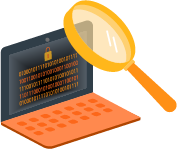Cybersecurity becomes increasingly complex with every passing year. The dynamic nature of modern cloud-based operations means that enterprise attack surfaces grow and change at unseen speeds. Furthermore, network perimeters aren’t what they used to be.
The proliferation of digital identities and endpoints requires more than what traditional cybersecurity has to offer. Enterprises need a more holistic and all-encompassing security model. Zero-trust security is the perfect solution for companies operating out of on-premises data centers, cloud infrastructures from various providers, or a hybrid model.
According to Gartner, 1 out of 10 major enterprises will have an effective and matured zero-trust security architecture in place in the next two years. This is a major indicator that enterprises are starting to understand that robust cybersecurity in the 21st century is difficult without a zero-trust architecture. As of last year, not even 1% of organizations had a comprehensive zero-trust strategy in place.
Zero-trust implementation is essential but can be a complex undertaking. Various cloud service providers may offer security solutions and frameworks that may seem like a healthy alternative. However, businesses should never pass on security responsibilities to third-party providers. Instead, they must implement zero-trust security and completely control their defenses.
It’s easy to understand the importance of zero-trust security. However, no enterprise can just implement a zero-trust solution without meticulous planning and precision. Zero-trust implementation will introduce enterprises to a profoundly different kind of cybersecurity. Therefore, the zero-trust journey is just as important as the destination. The quality of zero-trust implementation will define the quality of an enterprise’s overall cybersecurity posture.
Before we delve into how to kickstart a zero-trust journey, let us explore this unique security model in further detail.
What is Zero-Trust Security?
A zero-trust architecture is a unique cybersecurity approach that presupposes no user or activity within an enterprise’s IT ecosystem is legitimate or safe. By assuming that every entity within an enterprise network is dangerous, zero-trust solutions severely restrict user access and require multiple levels of authorization and authentication before granting secure access.
According to CISA, there are five critical pillars of a zero-trust architecture. These pillars are identities, devices, networks, data, and workloads. Neglecting any of these critical pillars will result in an incomplete zero-trust implementation and a weak security posture. Each of these pillars forms a part of an enterprise’s attack surface. Exploiting vulnerabilities in these pillars will allow threat actors to gain unlawful access to enterprise IT ecosystems and lead them to sensitive data.
Zero-trust security is essential because legacy cloud security models assume that every entity within an enterprise’s network perimeter is safe. In many instances, this allowed threat actors to infiltrate private IT ecosystems and hijack user identities to enable lateral movement. A zero-trust architecture helps organizations optimize their defenses and secure themselves against the next generation of cybercriminals.
The zero-trust solutions market will reach a value of $67.9 billion by 2028, rising at a compound annual growth rate of almost 17% since 2023. It’s evident that more and more enterprises are buying into the zero-trust approach. Zero-trust strategies can reduce the likelihood of cyberattacks, secure the network perimeter, identify and address security incidents in real-time, and find a perfect balance between end-user experience, enhanced functionality, and a robust security posture.
Key Components of Zero-Trust Security
The overarching philosophy of zero-trust security is “never trust, always verify.” This means that every request to access an enterprise network will have to go past multiple security checkpoints. Multi-factor authentication (MFA), a critical element of zero-trust security, is a good example of the “never trust, always verify” in action. All user identities must prove their legitimacy by providing different kinds of evidence. For example, a user might have to provide a password as one form of authentication and a biometric authentication as a follow-up.
The principle of least privilege is another important aspect of zero-trust architecture. It helps businesses optimize access controls and permissions. Least privilege states that no user within an enterprise network should be able to access or alter critical resources unless it directly connects to their line of work. Overprivileged user identities are dangerous attack vectors that threat actors can easily exploit to cause data breaches.
Just-in-time access supports least-privilege access as a powerful way to ensure that no user identity, human or machine, has long-term access to sensitive data. Most users within an enterprise network require access and permissions for specific tasks. Therefore, there is no need for them to have constant access permissions and privileges.
Businesses can use many other key features of zero-trust security to support its fundamental tenets. They include constant monitoring and visibility, data encryption, single sign-on (SSO) mechanisms, comprehensive identity and access management (IAM) practices, micro-segmentation, granular access controls, and endpoint certification.
Understanding Zero-Trust Network Access (ZTNA)
When exploring zero-trust security models, businesses will likely come across zero-trust network access (ZTNA). ZTNA is not the same as zero-trust. Instead, it’s an important component of a zero-trust security model. In some ways, it can be considered as a next-generation progression from traditional VPNs. The difference is that VPNs, like most legacy security solutions, don’t presuppose that their users are dangerous. ZTNA, much in alignment with zero-trust frameworks and principles, trusts no one.
ZTNA has many important use cases. It can protect enterprise apps irrespective of where they are located. For instance, ZTNA makes it irrelevant whether a particular app is hosted on on-premiere data centers, multi-cloud environments, or hybrid cloud infrastructures. ZTNA is location-agnostic because security is based on multifactor authentication, granular access controls, highly contextual security policies, and high levels of encryption.
According to Gartner, 7 out of 10 remote access deployments will go for ZTNA solutions instead of VPNs by 2025. This is a quick and radical shift because less than one out of every ten remote access deployments used ZTNA in 2021. Businesses need to remember not to use zero-trust security and ZTNA as synonyms. However, they need to know how the two concepts are linked and how to implement a zero-trust security model successfully.
A Guide to Zero-Trust Implementation
Businesses can’t adopt a zero-trust architecture on a whim. It needs to be a highly strategic and meticulously planned process. End-to-end zero-trust implementation can potentially take years. The following is a step-by-step guide on successfully implementing a zero-trust security model.
Step 1: Identify Key Stakeholders
Zero-trust security needs the buy-in of key stakeholders from various branches of an organization. A company can’t successfully implement zero-trust security unless everyone is on the same page. Therefore, the first step is to identify key stakeholders and ensure they are convinced of the enterprise’s new security model.
Zero-trust security implementation is impossible without a dynamic and powerful team. Enterprises must ensure that their zero-trust teams comprise diverse professionals from security operations, risk management, data security, and IAM backgrounds. Once an enterprise puts together a team to implement zero-trust, it’s time to assess the current state of the IT ecosystem.
Step 2: Current State Assessment
The zero-trust security team needs to conduct a comprehensive current state assessment. This involves mapping IT assets across on-premises, multi-cloud, and hybrid environments. Assets include hardware like internet-of-things (IoT) devices, remote endpoints, and various software applications.
This current state assessment will provide insights into potential attack paths and blast radii. It will also help the zero-trust security team understand how they need to conduct network segmentation to break down their ecosystem into granular and isolated segments with unique network security policies. As part of the current state assessment, businesses should identify critical workflows to understand who needs access to what resources.
Step 3: Frame and Implement Security Policies
Once the zero-trust team has completed a thorough current state assessment and understands every security intricacy in their IT environments, it’s time to frame and implement zero-trust policies. Zero-trust policies will micro-segment the network to limit the blast radii of cyberattacks and ensure that no user has any irrelevant or unauthorized access privileges. The policies need to address a few simple questions: who can access certain resources, why do they need that access, what should they do to gain access, and how long do access privileges last?
In this stage, businesses will begin introducing the different layers of zero-trust security, such as MFA, 24/7 monitoring tools, and continuous verification mechanisms. The zero-trust team should get insights and feedback from key stakeholders to ensure that they implement only the most important and optimized security policies. They must also ensure equal and comprehensive protection of the five pillars of a zero-trust architecture - identities, devices, networks, data, and workloads. A zero-trust security model is only effective if all five pillars are strong.
Step 4: Monitor and Analyze the Zero-Trust Model
The implementation of zero-trust security policies marks the official transition to a new cybersecurity model. However, it would be unwise to see that as the end of the zero-trust implementation process. Zero-trust is complex and requires iterative modifications to be truly effective. Therefore, the critical thing for zero-trust teams to do now is to monitor, analyze, and evaluate the success of their zero-trust security architecture.
During this stage, it’s important to analyze the zero-trust security model from different perspectives. Businesses should understand how the zero-trust architecture implicates and affects various stakeholders and processes. Furthermore, it’s essential to generate reports so that various teams, employees, members of the C-suite, and even the board of directors are in the loop. If anyone flags suboptimal elements or security weaknesses, then new security policies should replace old ones.
Step 5: Create a Zero-Trust Culture
Zero-trust security policies are robust tools for implementing a new security model. However, security is more than just technologies and policies. The fact is that every employee within the organization has to orient themselves with a radically different security model. This can take time, potentially cause productivity lulls and a drop in morale, and even lead to security mistakes. That’s why it’s vital to ensure that zero-trust becomes a part of the business’s security culture.
Some methods to do that include running zero-trust security awareness and training programs and creating a culture of accountability and pride in security. The discourse on zero-trust security revolves around bulletproof fortifications, but businesses should never forget that zero-trust is not about denying access. It’s about enabling secure access for legitimate users.
Step 6: Gather and Leverage Zero-Trust Threat Intelligence
A newly implemented zero-trust security model will reveal plenty of information about an enterprise’s cybersecurity posture and the looming threat landscape that lies beyond it. It will reveal information about why cybercriminals target certain pillars of IT environments, how they plan to facilitate lateral movement, and what crown jewels they are targeting. The obvious benefit to knowing this information is to further optimize the zero-trust architecture to prevent unauthorized access and data exfiltration. However, this information can also be very useful for a wider community.
Often, there are patterns in cyberattacks that companies in the same geographies or sectors may share. Creating a widespread threat intelligence program and community can help multiple organizations avoid the fallout of data breaches. They can also learn about what kinds of dangerous malware and ransomware to look out for and how to mitigate those threats.
Conclusion
Zero-trust security architecture is a powerful model of cybersecurity that can prevent data breaches, streamline user access, and create a more robust security posture. Businesses have hundreds of security threats to reckon with, ranging from malware to intricate API vulnerabilities. Furthermore, remote work models introduce multiple new endpoints and digital identities, making perimeter-based security an archaic and relatively ineffective model.
The solution is zero-trust, a model focused on continuous verification and authentication, one that assumes that all users are potential threats and no user needs any access that’s even slightly irrelevant. Zero trust has five main pillars - identities, devices, networks, data, and workloads.
The key to implementing a zero-trust security model that secures these critical pillars is following a meticulous six-step process: identify key stakeholders, conduct a current state assessment, frame and implement security policies, monitor and analyze the zero-trust environment for further optimization, nurture a zero-trust culture, and leverage zero-trust threat intelligence data to share with a wider community.
If an enterprise carefully follows these steps, then zero-trust implementation will be successful, and even the most dangerous threat actors will have no chance of breaching enterprise networks.
Categories: Security, Strategy, Data, Cyber Security, IT Management, Network Security, Proactive Network Security, Security Breach, Cloud Computing Security, Managed Security Services, IT Security, Email Security, Endpoint Detection and Response, EDR, Cyber Attack, Encryption, IT











